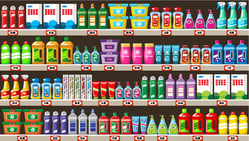 Have you ever thought about how much plastic products are integrated into your everyday life? If you stop to think about it, chances are you touch something made from plastic every day. For decades plastic materials have helped provide us with products that help us live a clean, healthy and efficient lifestyle and are used in a vast range of products from plastic bottles, cups and plates, to composite furniture and building products, and even in automotive components.
Have you ever thought about how much plastic products are integrated into your everyday life? If you stop to think about it, chances are you touch something made from plastic every day. For decades plastic materials have helped provide us with products that help us live a clean, healthy and efficient lifestyle and are used in a vast range of products from plastic bottles, cups and plates, to composite furniture and building products, and even in automotive components.
However, for all of the benefits that plastics afford us in modern society, it comes at a cost in regards to the natural resources required and the environmental impact during their lifecycle. As a result, studies have shown that consumers and brand owners are becoming increasingly  more concerned with the sustainability of their packaging. In addition, organizations such as the Environmental Protection Agency (EPA) and the Department of Energy (DOE) have encouraged the development of innovations that reduce petrochemical usage, greenhouse gas emissions, and other pollutants over a products lifecycle.
more concerned with the sustainability of their packaging. In addition, organizations such as the Environmental Protection Agency (EPA) and the Department of Energy (DOE) have encouraged the development of innovations that reduce petrochemical usage, greenhouse gas emissions, and other pollutants over a products lifecycle.
One way that you can help to reduce the environmental footprint of your packaging is through the use of a mineral filler such as Calcium Carbonate. Calcium carbonate is the main mineral found in limestone, marble and chalk, and is a natural resource that can be found in all parts of the world. Not only does the use of this mineral offer a cost savings through the displacement of resin but adding calcium carbonate to plastic has also been shown to offer added benefits such as faster heating and cooling, significant energy savings as a result of improved productivity, and higher outputs. As a result of these benefits the use of CaCO3 in plastics has been steadily increasing over the years.
In addition to these benefits, adding CaCO3 into plastic products has also been shown to lower the greenhouse gas impact of the end-use product. Use of CaCO3 in plastics reduces petrochemical and energy usage during the manufacturing process, minimizing the carbon footprint and greenhouse gas impact of finished plastic products. Studies conducted by Heritage Plastics have shown that using a 40% loaded calcium carbonate filled polypropylene can generate a Green House Gas savings of approximately 23% - and this is before taking into consideration the increased productivity mentioned.
Additional tests conducted by Heritage Plastics have shown that displacing just 20% of petrochemicals with calcium carbonate additives can result in significant environmental benefits including:
- 15-20% overall energy savings
- 16-20% reduction in the use of crude oil
- 15-19% reduction in the use of natural gas
- 12-17% reduction in the use of coal
- 12-16% reduction in the use electricity
- 13-17% reduction of greenhouse gasses
- 15-20% reduction of oxides of sulfur (SOx)
- 13-17% reduction of oxides of nitrogen (NOx)
- 11-15% reduction of particulates
The charts below detail the energy savings by using 20% HM10 calcium carbonate concentrate from Heritage Plastics in HDPE during the pre-film production stage as well as during film production:

Interested in exploring the use of a mineral filled polypropylene product? Download more information on our Polypropylene Solutions today!





